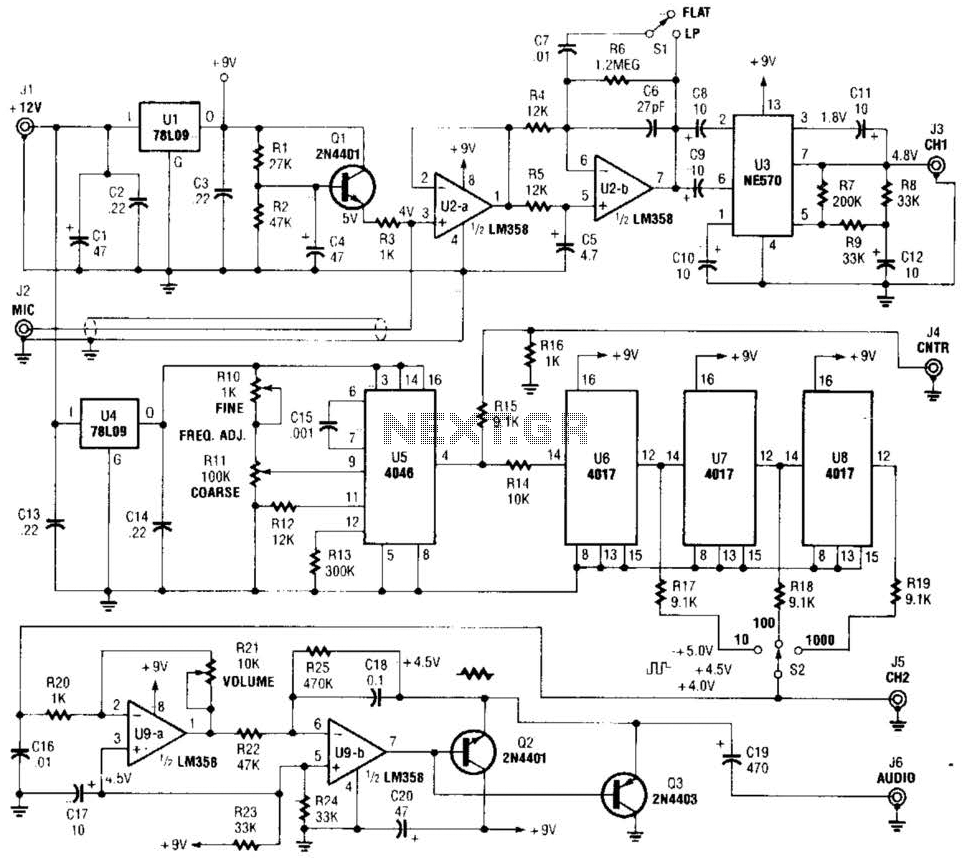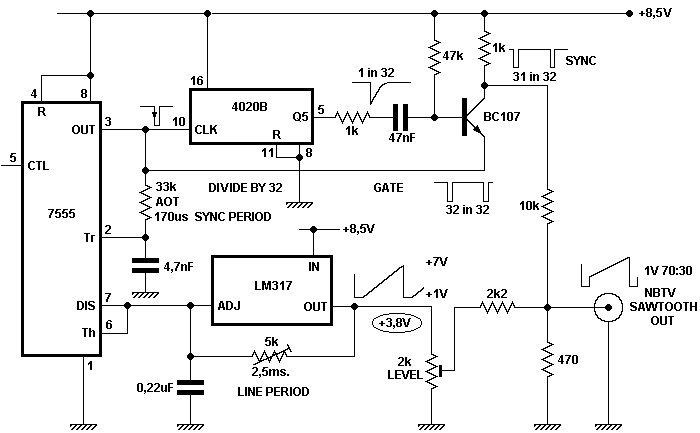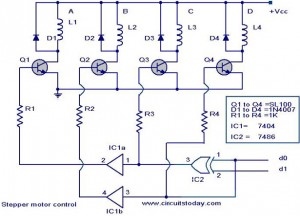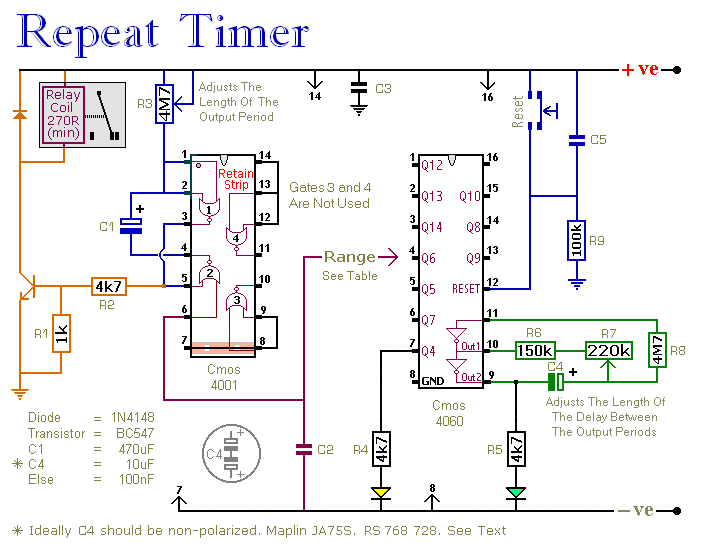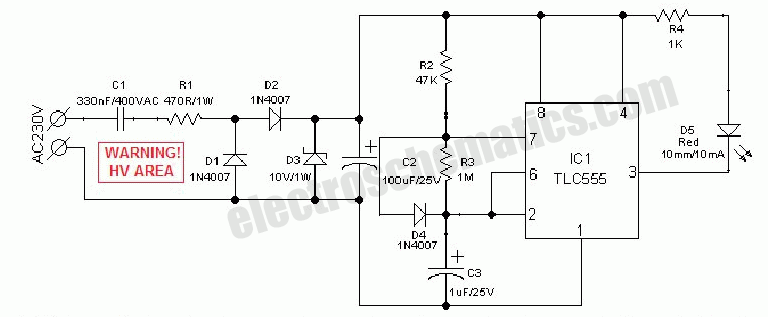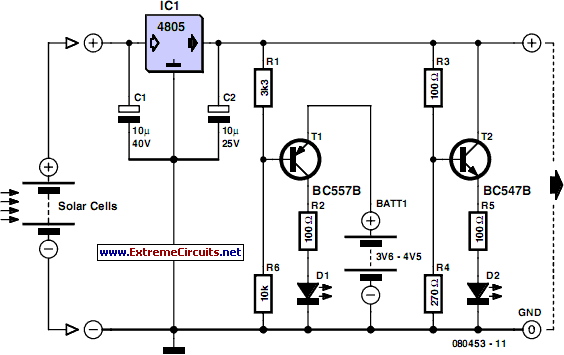
AM Receiver Circuit Using Transistor

This design features a simple yet effective receiver with good sensitivity and selectivity. The circuit utilizes a compact three-transistor regenerative receiver with fixed feedback, primarily based on the BC549 transistor. The tuned circuit is intended for medium wave frequencies but can operate at significantly higher frequencies with the appropriate tuning coil and capacitor modifications. Transistors Q1 and Q2 form a compound transistor pair that provides high gain and very high input impedance, which is crucial to prevent excessive loading of the tank circuit. Q1 functions as an emitter follower, while Q2 operates in a common emitter configuration. Self-stabilizing biasing is achieved through a 120k ohm resistor and the tuning coil. In this configuration, the base voltage of Q2 is approximately 0.71V, as observed in test samples. The 120k ohm resistor also facilitates regenerative feedback between the output of Q2 and the input of the tank circuit, influencing the overall performance of the circuit. The tuning coil can be salvaged from an old AM receiver, or alternatively, it can be constructed by winding 50 to 60 turns of 26 SWG enamel-coated copper wire around a 3/8 inch ferrite rod that is about 3 inches long. The circuit operates on a 9 VDC power supply.
The circuit design integrates several critical components that enhance its functionality. The BC549 transistors are chosen for their favorable characteristics, including low noise and high gain, which are essential for radio frequency applications. The regenerative feedback mechanism provided by the 120k ohm resistor is a key feature that allows for amplification of weak signals, thereby improving the overall sensitivity of the receiver.
The tuning circuit, which consists of the tuning coil and a variable capacitor, allows for the selection of the desired frequency. The use of a ferrite rod as a core for the tuning coil is advantageous as it increases the inductance, which in turn enhances the quality factor (Q) of the circuit, leading to better selectivity.
In practical applications, adjustments can be made to the tuning coil and capacitor to optimize the circuit for specific frequency ranges. For higher frequency operation, the inductance of the coil can be decreased by reducing the number of turns or by using a different core material.
Additionally, the circuit's layout should be considered to minimize parasitic capacitance and inductance, which can adversely affect performance. Proper grounding techniques and component placement can significantly influence the stability and reliability of the receiver.
Overall, this simple three-transistor regenerative receiver circuit is an excellent choice for medium wave and higher frequency applications, providing a robust platform for further experimentation and refinement in radio frequency engineering.This is the simple design and sensitivity and selectivity of the receiver are good. This circuit is use a compact three transistor, regenerative receiver with fixed feedback. The circuit is based on transistor as core of the operation. The transistor that is used is BC549. This is the figure of the circuit. The tuned circuit is designed for medium wave, but the circuit will work up to much higher frequencies if a different tuning coil and capacitor are used. Q1 and Q2 form a compound transistor pair featuring high gain and very high input impedance. This is necessary so as not to unduly load the tank circuit. Q1 operates in emitter follower, Q2 common emitter, self stabilizing bias is via the 120k resistor and the tuning coil.
As Q2 operates in common emitter its base voltage will be a V be drop higher than ground or about 0. 71V in my test sample. The 120k resistor provides regenerative feedback, between Q2 output and the tank circuit input and its value affects the overall performance of the whole circuit. The tuning coil can be salvaged from an old AM receiver. However to make your own wind about 50 to 60 turns of 26 swg enamel coated copper wire over a 3/8 inch ferrite rod about 3 inches long.
This circuit is powered by 9 VDC. 🔗 External reference
The circuit design integrates several critical components that enhance its functionality. The BC549 transistors are chosen for their favorable characteristics, including low noise and high gain, which are essential for radio frequency applications. The regenerative feedback mechanism provided by the 120k ohm resistor is a key feature that allows for amplification of weak signals, thereby improving the overall sensitivity of the receiver.
The tuning circuit, which consists of the tuning coil and a variable capacitor, allows for the selection of the desired frequency. The use of a ferrite rod as a core for the tuning coil is advantageous as it increases the inductance, which in turn enhances the quality factor (Q) of the circuit, leading to better selectivity.
In practical applications, adjustments can be made to the tuning coil and capacitor to optimize the circuit for specific frequency ranges. For higher frequency operation, the inductance of the coil can be decreased by reducing the number of turns or by using a different core material.
Additionally, the circuit's layout should be considered to minimize parasitic capacitance and inductance, which can adversely affect performance. Proper grounding techniques and component placement can significantly influence the stability and reliability of the receiver.
Overall, this simple three-transistor regenerative receiver circuit is an excellent choice for medium wave and higher frequency applications, providing a robust platform for further experimentation and refinement in radio frequency engineering.This is the simple design and sensitivity and selectivity of the receiver are good. This circuit is use a compact three transistor, regenerative receiver with fixed feedback. The circuit is based on transistor as core of the operation. The transistor that is used is BC549. This is the figure of the circuit. The tuned circuit is designed for medium wave, but the circuit will work up to much higher frequencies if a different tuning coil and capacitor are used. Q1 and Q2 form a compound transistor pair featuring high gain and very high input impedance. This is necessary so as not to unduly load the tank circuit. Q1 operates in emitter follower, Q2 common emitter, self stabilizing bias is via the 120k resistor and the tuning coil.
As Q2 operates in common emitter its base voltage will be a V be drop higher than ground or about 0. 71V in my test sample. The 120k resistor provides regenerative feedback, between Q2 output and the tank circuit input and its value affects the overall performance of the whole circuit. The tuning coil can be salvaged from an old AM receiver. However to make your own wind about 50 to 60 turns of 26 swg enamel coated copper wire over a 3/8 inch ferrite rod about 3 inches long.
This circuit is powered by 9 VDC. 🔗 External reference
